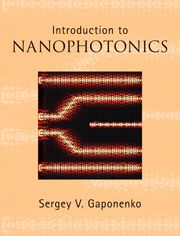Book contents
- Frontmatter
- Contents
- Preface
- Notations and acronyms
- 1 Introduction
- Part I Electrons and electromagnetic waves in nanostructures
- 2 Basic properties of electromagnetic waves and quantum particles
- 3 Wave optics versus wave mechanics I
- 4 Electrons in periodic structures and quantum confinement effects
- 5 Semiconductor nanocrystals (quantum dots)
- 6 Nanoplasmonics I: metal nanoparticles
- 7 Light in periodic structures: photonic crystals
- 8 Light in non-periodic structures
- 9 Photonic circuitry
- 10 Tunneling of light
- 11 Nanoplasmonics II: metal–dielectric nanostructures
- 12 Wave optics versus wave mechanics II
- Part II Light–matter interaction in nanostructures
- Author index
- Subject index
3 - Wave optics versus wave mechanics I
from Part I - Electrons and electromagnetic waves in nanostructures
Published online by Cambridge University Press: 05 June 2012
- Frontmatter
- Contents
- Preface
- Notations and acronyms
- 1 Introduction
- Part I Electrons and electromagnetic waves in nanostructures
- 2 Basic properties of electromagnetic waves and quantum particles
- 3 Wave optics versus wave mechanics I
- 4 Electrons in periodic structures and quantum confinement effects
- 5 Semiconductor nanocrystals (quantum dots)
- 6 Nanoplasmonics I: metal nanoparticles
- 7 Light in periodic structures: photonic crystals
- 8 Light in non-periodic structures
- 9 Photonic circuitry
- 10 Tunneling of light
- 11 Nanoplasmonics II: metal–dielectric nanostructures
- 12 Wave optics versus wave mechanics II
- Part II Light–matter interaction in nanostructures
- Author index
- Subject index
Summary
Let us return from optics to mechanics and explore the analogy to its fullest extent. In optics the old system of mechanics corresponds to intellectually operating with isolated mutually independent light rays. The new undulatory mechanics corresponds to the wave theory of light.
Erwin Schrödinger, Nobel lecture, 1933In this chapter we shall see that electromagnetic waves and electrons feature a number of common properties under conditions of spatial confinement. Simple and familiar problems from introductory quantum mechanics and textbook wave optics are recalled in this chapter to emphasize the basic features of waves in spatially inhomogeneous media. Herewith we make a first step towards understanding the properties of electrons and electromagnetic waves in nanostructures and notice that these properties in many instances are counterparts. Different formulas and statements of this chapter can be found in handbooks on quantum mechanics and wave optics. A few textbooks on quantum mechanics do consider analogies of propagation and reflection phenomena in wave optics with those in wave mechanics.
Isomorphism of the Schrödinger and Helmholtz equations
In Chapter 2 we discussed that an electron in quantum mechanics is described by the wave function, the square of its absolute value giving the probability of finding an electron at a specific point in space. This function satisfies the Schrödinger equation (2.56) which is the second-order differential equation with respect to space and the first-order differential equation with respect to time.
- Type
- Chapter
- Information
- Introduction to Nanophotonics , pp. 35 - 78Publisher: Cambridge University PressPrint publication year: 2010



